Field Dressing an Elk: Here’s How to Git ‘er Done!
Topics Related to Field Dressing:
Moving a Whole Elk
Caping An Elk for a Shoulder Mount
Gutless Field Dressing
Skinning Elk
Quartering Elk in the Field
Deboning Elk in the Field
Game Meat Processing: Bill's True Story
Elk Hunting With Horses
Getting Elk Meat Home Easier
Cooling Big Game in the Field
While field dressing, keep a lookout for approaching bears. Being attacked from behind by a bear while up to your elbows in elk guts is not the last experience you want to leave this earth with. Although, I could think of worse things.
Recent Articles
-
Elk Calling Done Right: Making Elk Sounds that Get You Close to Elk
Elk calling requires an understanding of what elk talk means and when they are used. With understanding and practice you can learn elk talk to use elk hunting calls effectively.
Take Pictures First
Upon reaching the carcass, first take pictures before you start cutting. An intact animal looks so much better in pictures.
(Click here for discussion about taking pictures of downed game.)
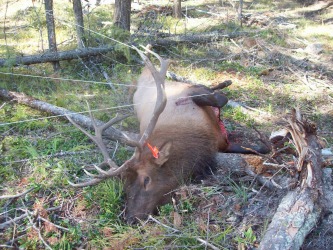
After photos, take out some light braided nylon rope and tie both front and back legs apart the best you can with the trees, brush or rocks that are available. Carry plenty of rope because you never know how close the trees, etc. will be. You might want to carry tent stakes in case there is nothing close to tie to.
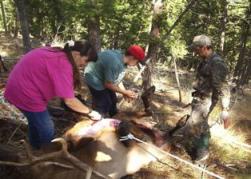
Gutting an elk is very difficult without the legs being held apart for you. You can field dress a deer by simply straddling the animal and pushing the legs out with your knees. The bigger, bulkier size of an elk makes that very difficult. If possible, keep it flat on its back when splitting it open to take some pressure off of the membrane you will be cutting.
You'll find a list of recommended equipment and tools for field dressing listed at the bottom of this page.
Cool It Down Quickly
Field dressing, removing entrails, right away is the first step in cooling your meat harvest down quickly. The gutless method is great, if quartering is done immediately. The sooner you bring the meat to a cool temperature, the better it will taste on the table.
The Gory Details of Field Dressing
I am now going to get into the gory, step by step details of field dressing an elk. If you’re getting ready to eat a meal, come back later to read the following.
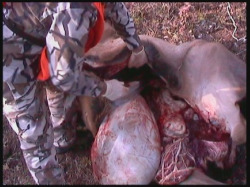
Even if you’re experienced at field dressing deer, but never an elk, you will be amazed at the huge volume of “guts” a big elk has.
Remember, if quartering or de-boning in the field that you probably need proof of sex. In some states, you need “evidence of sex naturally attached” to the biggest peace of meat from a quarter until final storage. Check the regulations where you will be hunting, in case you have to cut it up or quarter it on the ground before packing it out.
With some care, you can leave nothing but the scrotum or some mammary glands connected to a large piece of meat from a back quarter. There’s little choice other than leaving the head connected to some meat up front, which might be easier, if you’re hauling out a trophy head anyway.
Splitting the Carcass
With the animal on its back, split the carcass from just above the anus all the way to the top of the neck to start the field dressing process. This immediately begins to allow a lot heat to escape. (Careful caping may be needed for a trophy animal.) You will notice that there are basically three layers to cut through at the abdomen; the layer of hide and muscle, then the tough membrane that holds the stomach and other “innards”.
To avoid cutting into the guts, I like to cut through the hide and muscle first. Then, I make a cut just below the sternum through the tight membrane holding the guts. The sternum gives you a little more room away from the guts, so there is less chance of poking a stomach. Cut gently and lightly until you open this membrane a little. After cutting it, if you hear a hissing sound, duck! Either air had built up inside from a wound, or you accidentally cut the stomach. That can add some color to the field dressing chore, and possibly your face! With a little care, this can be avoided.
The Flip N Zip makes this job much cleaner and easier. You can't puncture the gut with it.

At this point, stick your index and middle finger inside the membrane with your palm up, fingers pointing toward the butt. Pull the skin and membrane tissue up from the guts and guide your knife between your fingers toward the butt end (blade up) to “unzip” the abdominal cavity (moving both hands forward at the same time). Your fingers will push the guts away from the tip of the blade until you reach the pelvic bone (arch).
There are gut hooks and other tools that make field dressing easier, if you want to spend the money, but this is not that hard to master with a regular knife. You still have to cut the abdomen open with a regular knife before unzipping with a gut hook anyway. That one cut just takes some finesse to avoid cutting something nasty inside.
For a bull (or buck), cut around the penis only enough to remove it from the skin. Do not cut the urethra that leads to the bladder. Cut it free from the skin and add it to the guts still attached. This and the bladder will all come out together later with the rest of the guts. I'll discuss the bladder issue and variation for field dressing a cow more below .
Now, you can cut all the way up to the top of the neck (unless caping a trophy) with no risk of cutting something nasty under the rib cage. Cut all the way down to the bone along the sternum.

Use a fold up saw, Sagen brand saw or Gerber E-Z Saw (in picture link) to cut through the sternum all the way up through the “collar bone”. Some people use a hatchet. It gets the job done, but a hatchet weighs more. I don’t want to pack one! A saw tends to poke at the organs as you move up and down. The Sagen saw is made with a blunt end that keeps from shredding the stuff inside. It is a short saw with a T-shaped handle and a blunt tip. They make a small one for deer and a larger one for field dressing elk.
You’ll notice that there is a thin membrane (muscle really) that separates the abdominal cavity (stomach and guts) from the thoracic cavity (lungs, heart, etc.) Get your hands in there and carefully cut the diaphragm as close to the inside of the rib cage as you can. All the way around. You’ll easily find this thin layer of muscle separating the two body cavities (abdominal/gut and thoracic/chest).
Cut the wind pipe along the neck somewhere. It might help to separate the two sides by jamming a stick between the two rib sides where the sternum is cut. (Will aid in cooling, too.) Now you can reach way up inside the chest cavity and grab that wind pipe. Start pulling and cutting behind it (next to the spine) to bring everything down a little at a time toward the butt end of the elk.
Tug, Cut and Pull!
You will then have to simply feel where all the organs are attached to the inside of the carcass and just keep carefully cutting it all loose and pulling it down. Watch your fingers. You don’t have to cut organs loose from the whole mass of “innards”. It all will stay together in one big “train”, all the way down, including the intestines. Just separate it all from the “wall” of the cavity.
Make small cuts at a time to avoid poking stuff that will only make the field dressing messier. This is the hardest part and there is no clean way to do it (other than the gutless method which requires fast removal of meat from the warm carcass). Wearing long plastic gloves will limit getting blood on your forearms, but not your elbows! We just use regular latex gloves to keep hands cleaner for handling meat or our own food later. Getting blood on your arms and clothes is part of this. If you’re good at it, you might avoid slinging blood on your face!
Everything inside the cavity clings to the sides and top of the cavity "walls". It seems to me the liver always gives me the most trouble, as it is ”glued” close to the wall of the cavity. Just cut it close to the wall until it is free. The big stomach is also tied to the walls.
To cut this stuff away from the wall, pull each organ or part away from the side wall and cut whatever is holding it. You can’t see behind all that stuff, so sometimes you have to go by feel. Unfortunately, in order to get in there with your hands, your face is not far away from the whole mess. I don’t think the field dressing process smells all that bad, unless I accidentally cut part of the digestive system or unless a bullet or arrow has opened it up. Then it’s foul to have your nose that close.
Continue to wrestle the guts, stomachs, other organs and stuff toward yourself. You end up having to pull it toward your own body to get it out. I like to have the animal lying with the back legs somewhat downhill during field dressing. I also prefer to shift it so it is lying on one side while pulling out guts (only after splitting it open).
Now, the problem with that is that it puts the full weight of all the heavy guts on the lower side of the carcass, but on its back the mass of stuff gives you problems all around, getting in the way of needed cuts. The areas that are tied to the lower side of the elk on its side are harder to get to after easily cutting all the stuff loose from the top side. So, if feasible, roll the animal over to the other side so the uncut side is now on top, letting gravity help you out. (It’s that dang gravity that makes the whole elk hunting job harder.) Then, flop it over again so you can pull and roll out the gut pile. (Easier said than done due to the weight of an elk.)
If you can't turn it over, you'll have to work underneath all the mass of guts and stuff with your hands and knife. You can move things around a little so you can cut beneath it. You will probably be working in a few inches of blood. If you can turn it over, or at least lean it over a little, it will make it easier.
The Stubborn Rectum and Bladder
Now there’s that little problem of the rectum and bladder. The rectum, inconveniently tucked under the pelvic arch, still holds on tightly to the intestine, which always contains elk poop pellets. The bladder is hidden under that pelvic arch, too. Getting poop or pee on your meat can taint the flavor. I haven’t always split the arch, but it makes the job easier to deal with the bladder and rectum.
I have used a saw and a hatchet to do this. Either way, just because it is split does not mean the intestines will come through that separated bone. It's often easier to make two cuts to remove a chunk of bone on an elk pelvic arch. I used to have a little length of cutting cable with finger loops on each end. If anyone knows where to find those, let us know in the comments section below. It worked on deer anyway, until I broke it.
I always save the rectum until last. Some don’t. That’s my choice because I think it’s easier to "core" it with a knife once I can see better from both sides. You do eventually need to separate the butt hole from the skin around it. I like to tighten things up a bit by pulling from the inside and cutting around the butt hole from the outside. Once you get it loose, a zip tie does a great job of keeping the contents off your meat when you pull it inside.
Some say it is easiest to stick your finger or thumb in the rectum and cut around your finger. If you play "procotologist", change your gloves afterward.
Butt Out!

"Butt Out!", from Hunter Specialties, is a tool designed for deer to detach the rectum and intestine, in one piece, from surrounding tissue with no cutting. (Click on picture.)
I've used it for deer. It works great! It does not work for elk. It's not big enough. Don't bother trying it. Maybe they'll make a larger version for elk some day. Get one for deer. Excellent!
You simply stick it in the rectum, turn twice, then pull a few inches of intestine outside the body. After using the Butt Out you simply pull the loose intestine inward with the freed rectum attached, no cutting needed around the butt hole. Again, it doesn't work for elk!
Anyway, after cutting around the rectum, everything from the chest cavity to the rectum is still all hanging together and ready to be pulled away from your meat. Feel free to save the tongue, liver, heart or whatever else you want to eat. I’ll pass!
Truth be told, I don't cut around the rectum. I leave it intact and tie the intestines with string inside in two places, then cut between the ties. Poop is secure. It stays with the bones when it's quartered. Keep it off your meat.
The Bladder
Now, for the bladder. You'll find it under the pelvic arch. If you have left the penis intact, it will not leak and the bladder will come out with the rest of the guts. If you're field dressing a cow (or doe), you will have to separate it from the vagina. You can either cut around it from the outside, or pinch the plumbing that goes to it, carefully cut it and remove the bladder quickly from the scene.
The bladder won’t easily break. It won't leak unless you poke it or cut the tube too close to the bladder. As with the rectum, we leave it and it stays with the bones when quartered. It takes some finesse and practice not to break it, though.
If you do get pee or poop on your meat, rinse it well and wipe it with a clean cloth.
(What if you find cysts in the lung or liver?)
Drain the Carcass, if Feasible
It’s a good idea at this point, if you are taking out a whole carcass, to drain the blood out of the cavity by turning the elk over on its cut open belly. Let the blood drain out by rocking the carcass around, then wipe out the inside with a cloth. If I can drain it pretty well, I don’t always wipe it out.
I don’t mean to make repositioning of an elk carcass sound easy. It’s not easy to roll one over and sometimes not feasible. Sometimes the slope is too steep or a tree or rock is in the way, etc. Just do the best you can.
It’s easy to roll over a deer, but elk are very heavy. If you can’t dump out the blood get as much as you can out to help it cool down inside. Soak some up with a rag.
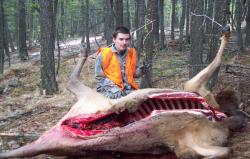
There will still be wads of fat and other tissue stuck to the inside of the carcass. The more you remove, the cleaner it will be. Truth be told, I always leave lots of stuff in there and all is well in the end (excuse the pun). In fact, I usually do the gutless method, unless I can load it whole and hang it to finish the job.
I have even left the rectum alone with a section of the intestine still attached. When I do that I pull as much of the poop pellets (you can feel them inside of the intestine) away from the anus with my hand before cutting the intestine a good ways from the rectum.
In other words, squeeze the intestine with one hand, and then slide your closed hand away from the butt. Most of the pellets will be pulled away, leaving an empty section of intestine.
Cut and tie that end off and neither end will allow the remaining poop pellets from getting loose and running around. It’s impossible to pull away all the turds from down there, so you have to tie it off with some string or a zip tie, so they won't come out.
It’s better to remove the rectum as described above, but field dressing is not an art form. People do this stuff different ways and have their own opinions and methods. I've field dressed well over a hundred big game animals. I've never lost any meat and never had an elk that tasted "gamey".
Field dressing is now complete. You’re ready to haul the carcass out whole or to quarter it, if you don’t mind carrying heavy bones., Or for cutting the meat off the bones. (Click here to read about deboning elk.)
If hauling it out whole, you might want to have frozen jugs of ice (milk jugs or large pop bottles) to stick in the cavity for the trip home to cool it down. We've bought ice on the way home and stuck the bags in there, as well. The faster you cool it, the better the meat will taste. We prefer de-boning in the field for that reason.
Want to avoid all of the above nasty stuff? Click here for the gutless method.
For detailed instructions for skinning elk, click here.
Suggested items and tools for
field dressing elk or other big game:
• camera (before cutting)
• light clothing (if needed, as this job warms you up!)
• pepper spray (for protection from bear)
• braided nylon rope (for tying legs apart)
• tent stakes (optional, in case there is nothing to tie to)
• two sharp knives (or more)
• dozen latex gloves (change often to keep from soiling meat)
• vinyl tablecloth or small tarp (to put meat on, to keep it clean)
• clean rags (save clean ones to wipe out body cavity)
• inexpensive cotton cord (for lashing meat to pack)
• game bags (good quality kind can be rewashed/reused)
• wet wipes (nice before eating a snack after a dirty job)
• headlamp flashlights (just in case)
• Sagen or Gerber E-Z Saw (optional for splitting sternum or pelvic arch without cutting bladder)
• Hunter's Specialties Butt Out Big Game Dressing Tool (great for deer, not for elk!)
Please subscribe to or our Quick Elk Hunting Tips and Updatesnewsletter or to an RSS feed (see left column for both) to be alerted whenever new information is added to the site.
We'd appreciate it if you would "Like" us on Facebook, or share this site with others.
Search this site here:
Shop Our Store
Newsletter Opt-in:
"I just get so excited talking about elk.." ~Tristan, CO
Search This Site Here:
Hunting Gear Reviews
ASAT CamoElkNut Outdoor Prod.
Bugling Bull Game Calls
HECS Stealthscreen
Montana Decoy
StringSling Bow Sling
Skull Hookers
Safari Sling Rifle Sling
Clip-Shot Mini Camera Mount
ASAT Camo
Bugling Bull
Game Calls
ElkNut Productions
Free Shipping on
ElkNut Products Here
HECS Stealthscreen:
A New Type of Concealment!
$199.99,
Including U.S. Shipping
Montana Decoy Elk/Deer
Available Here!
The StringSling:
Best Bow Sling Design!
$29.95, Including U.S. Shipping
Clip-Shot: 1 oz. Camera Mount
Skull Hookers
$34.99 & 59.99 Free U.S. Shipping!
The Safari Sling:
Best Rifle Sling Design!
Share your elk hunting pictures and stories on our
Facebook Page!
Forum Topic Discussions:
How often should I use my cow call?, I am new to the sport of bow hunting elk and my question is how often should I use my cow calls?
295 yard kill with a Kimber Montana 325 WSM, by Don from Dallas: My ELk did not even twitch once. He was dead when he hit the ground.
325 WSM is worth considering, Palmer Lake,CO: I believe that the .325 WSM is the ultimate elk caliber...
30-30 for Elk? : I have a 30 30 with 170 grain round nose bullet. Will this work to shoot an elk ?
(More comments about Best Elk Rifle below)
Submissions
Unique Elk Talk by Idaho Steve (Hailey, Id ), In the middle of the night, a herd of elk came traveling through the drainage and right past my tent...
Smelly Elk Areas? by Jimmy (New Mexico), I've come across many areas that just stink of elk, literally. I have heard two somewhat contradictory stories...
DIY Gear List Must Have's! by Craig (Florida) "Here are some of the items I use on my DIY hunts in the CO backcountry..."
Elk and Deer Hunting and Mountain Bikes, by Skip Shepherd (Tucson, AZ)~ At 67 I am thinking a lot about investing in a mountain bike to get back into remote areas...
Solo archery hunting -- tips for calling/set up?, by Idaho Steve (Hailey, ID )~ I hunt by myself a lot...I'd love to hear your thoughts on strategic set-ups when solo hunting and calling.
Non- Lead Bullets for Elk?, by Dave, Elk Hunting Tips.Net (Garrison, MT)~ What do you ballistics guys think about the use of non-lead bullets for elk? According to this story...
Rage Broadheads by Chris, ...my buddy gave me a rage practice tip and when I shot it you could not pick out the broadhead from the field points. I was sold...
Recent Submissions:
Finally filled the freezer..., Colorado Rockies~ "I was bummed when I got to the property and no elk, nor any hoof prints in the snow. ...I pulled each of the elk into shade then started gutting..."
Wounded Veteran Elk hunts, by Joshua FL), I am a disabled veteran of Operation Iraqi Freedom and have always dreamed of hunting elk. I am posting this to see if anyone would know of any elk hunts free to disabled vets....
First Elk with a Bow, by Ryan H. (Colorado), ...Finally after many years of hunting with a bow "I got er did"!
First Elk!, by Tater (Sheridan, Arkansas) I took the advice I received from this website and was successful…I wanted to Thank You and Your Forum and the folks that share on here for the knowledge and information that helped me find an elk I was quite happy with.
Any success in Unit 14?, by: Dave (MI), "I'm planning on doing a DIY in Unit 14 for 2012..."
Bugle in Herd bulls, by Swiltbank (Az) The key to calling in a herd bull is to get into his bedding grounds and threaten his herd. Start off sounding like…
Best Rifle Caliber?, by Buglemup (Superior, MT), "I've been reading what people have been writing about rifle calibers and here is what 16 years of guiding elk has taught me."
7mm Remington Magnum, by Dean (Helena, MT. USA) I use my Liberty Ruger M77, 7mm Rem. Mag. for antelope, deer, elk... Comment: "What do you guys think about the idea of hunting elk with a 270? I also know a guy who kills elk with a 243."
338 Marlin Express, "Light, fast shooting, hard hitting, manageable recoil, and for a lever gun - very accurate."
Guns I like for Elk, by Mountain Walker (Kootenays east B.C. Canada),"I think the gun you shoot Elk with should be one you shoot a lot with... "
.35 Remington, by Bill Smith "...my .35 Rem appears to have dropped a medium deer flawlessly, but I now have serious doubts as to its capability to take an elk."
Where to hunt in Az unit 3B?, by Cliffjumper (Tucson, Az) ~ I got a late bull muzzle loader hunt in Arizona unit 3b. Does anyone know how to hunt bulls in the late season?...
First time elk hunter hunting Arizona unit 6A , by Rob Marchio (Omaha, Ne)~ I'm a first time elk hunter hunting Arizona's unit 6A. I'm planning on staying in the Pine Grove campground...
Help needed for 1st DIY Hunt w/Son, by Patrick (Parker, CO), "I was looking for some advice on my 1st DIY hunt for 2014 in CO with my 13 yr old son. I have countless hrs going over stats, topo maps & Google Earth"
Elk Hunting Colorado in 2013, By William (Midland, TX) "I am planning an elk hunt next year in Colorado and I wanted to know if hunting Gunnison National Forest..."
Unit 60 Elk 4th Rifle Season Nov 13-17 Either Sex 2013, By Chester "...Any general advice about the unit would be appreciated!"
Elk Hunting Idaho Unit 8 8A 11, This is my first year seriously trying to track down some elk. Is there anyone that has hunted in any of these units and can give me some friendly advice? Mitchell, Moscow Idaho
Elk Hunting Pocatello by Cameron (Pocatello) Where is the best place to elk hunt around Pocatello, Idaho? I'm a student at ISU and I'm looking for somewhere around here to hunt next season.
How is the elk hunting in unit 30A in Idaho?, by Terry (Richland Center, WI) Has anyone archery elk hunted in unit 30A in Idaho? What can you tell me about the area?
Hunting in Western Montana, by Mike A. (Alabama)
I did not draw a tag for Missouri breaks where I have hunted in the past. Having to start over and try western Montana.
New Mexico Unit 49, by Silas (Los Alamos, NM)
If anyone has tips on areas to start scouting, I'd really appreciate it.
First Elk Hunt First Elk Hunt, by Big "R" (NM)
I finally got drawn for a late elk hunt in Unit 28, north of Road 506 and south of the boundary line of the Lincoln National Forest...
Cow elk in Nevada's unit 222:
"Any good places known in unit 222?"
Northeast Nevada Early Elk hunt, by John (Carson City,NV)
"Any suggestions on what areas I may see some signs of elk?"
Retired USMC MSgt Needs Advice, by Ken Wing USMCRET (Bealeton, Va)
Popcorn VenisonPopcorn Venison with Maple Syrup?
Elk or Venison Steaks Grilled to Perfection Here's how to turn them into steakhouse steaks!
Spice-Crusted Grilled Venison Roast Recipe This Spice-Crusted, Grilled Venison Roast recipe works great for any red meat roasts, including elk, deer or beef roast...
Corned Elk Recipe You can easily make corned venison and elk, moose or corned beef from these instructions...






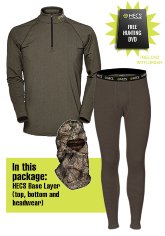
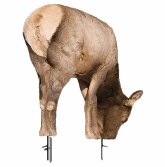

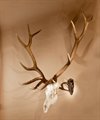
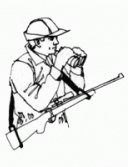
New! Comments
Leave a comment in the box below.